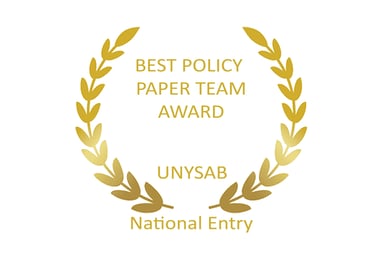
Sustainable Management and Usage of Natural Resources by Mitigating Waste Generation through Recycling and reuse
Bangladesh is now the most polluted country globally. The pollution rate in our country is increasing day by day. If we cannot take the proper steps, the situation will get out of reach. At this moment, we have to think more rationally to overcome this hazardous situation.
SUSTAINABLE LIVINGFEATUREDINNOVATION
Mahmuda Yasmin Dola
9/1/20224 min read

Image: SDG Agenda No., 12

The Agenda Synopsis:
Bangladesh is now the most polluted country globally. The pollution rate in our country is increasing day by day. If we cannot take the proper steps, the situation will get out of reach. At this moment, we have to think more rationally to overcome this hazardous situation. Responsible consumption and production can bring about massive change. Excessive consumption of products and how we release them into the environment without any worries after using them has become a threat to the environment. We need to reduce surplus products and recycle and reuse used products. Every individual can make a significant difference by reducing waste and recycling. Every day, we can make a difference. Recycling is an environment-conscious practice that helps minimize trash disposal requirements while promoting resource sustainability. Sustainability meets our immediate resource needs without endangering future generations' needs. Recycling helps preserve natural resources and alleviate the environmental impact stemming from mining, logging, and raw material processing. It saves energy as it requires less energy to process recyclable items than collecting, transporting, and processing raw materials. It also contributes to environmental protection by reducing the demand for landfill space and keeping our air cleaner.
In-depth Explanation:
We have to take the zero-waste initiative right now. It is time to manage and use sustainable natural resources by reducing waste production through recycling and reuse.
Recycling textile products: Bangladesh is the second-largest exporter of garments globally [Source: WTO's World Statistical Review 2023]. A large amount of discarded textiles are emitted into the environment. Recycling these discarded products will reduce pollution in the environment. We are transforming these garments' products into eco-friendly bricks. This method, called the 'FabBrick' approach, prevents textile waste. Soft fabrics turn into solid walls that are insulating, structural, acoustic proof, thermal proof, and aesthetic building material. These soft fabrics are also used for making furniture and partition walls. Again, recycling old clothes can turn into new clothes.
Recycling Face-mask waste, PPE kits waste: Face masks have become an essential tool in the COVID-19 pandemic situation, but they are also proving to be a primary source of pollution, which is seen in the countryside, littering streets and waterways across the country. The concept of waste products turning into eco-friendly products such as bricks and furniture has to be utilized in our country. These materials are safe and sanitized. They are also waterproof and fire-resistant.
Recycling plastic trash: Plastic trash is now a global problem. Plastic wastes can turn into construction bricks by mixing plastic and sand at a very high temperature, making doughlike materials, and then molding them into brick shapes. This brick is cheaper and more affordable for pavements, walkways, roofing tiles, drainage gutters, and many more. Also, old plastic bottles can turn into lightbulbs, and bottle cutters turn bottles into strips.
Recycling organic materials: Rotting vegetables can make electricity. It produces biogas, which later turns into electricity. Biogas is plentiful, low-tech, and burns cleaner than any fossil fuel. It reduces landfill waste. Besides this energy, the plant creates another valuable byproduct: fertilizer.
Again, foam materials and plastic sandals from Algae and plants can reduce plastic pollution. Algae are the most photosynthetic organisms, which are easy to grow and harvest in artificial ponds, using less land than plants. The process of turning Algae into flip-flops is quite simple. The shoe consists of a footbed made from flexible foam, an outsole of more rigid foam, and a cotton strap. The sandal is 100% biodegradable. This is the plastic-alternative material. Thus, we can turn Algae into a low-cost, low-emission biofuel.
Banana tree waste can become fabric, rugs, carpets, hair extensions, and clothes. These are biodegradable and more sustainable. Banana fiber absorbs dyes better than cotton, requiring less water and less land to produce. In addition, discarded flowers may turn into incense sticks.
Conclusion:
The possible policy measures have been implemented depending on the circumstances:
1. We have to generate electricity through recycling of rotting vegetables. Aside from energy, it also creates another valuable byproduct: fertilizer.
2. To turn potentially hazardous waste like Face masks, PPE kits, and gloves into valuable materials such as Eco-bricks, plastic furniture, and many more.
3. To transform discarded textile products into eco-friendly bricks, furniture, partition walls, and valuable products.
4. To transform plastic trash such as bottles, containers, and others into construction bricks.
5. To make foams and flip-flop materials from Algae and plants, reducing plastic pollution.
6. To use waste flowers to make incense sticks.
7. To utilize banana tree waste to turn it into fabric, rugs, carpets, clothes, and hair extensions.
8. Recycle the discarded tires to make new products and turn them into energy.
9. To create more plastic alternative materials.
10. We have to use a sea bin which collects garbage from the sea.
11. We can make eco-friendly seed masks that can grow into plants upon their disposal.
12. We should increase the quantity of jute products without plastic at all levels.



Meet The Author


Related Articles





